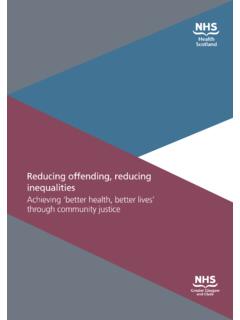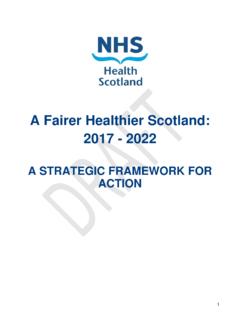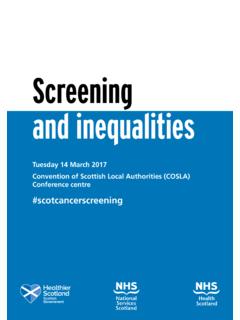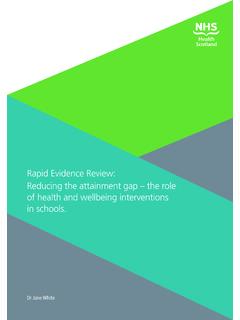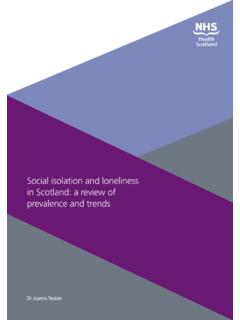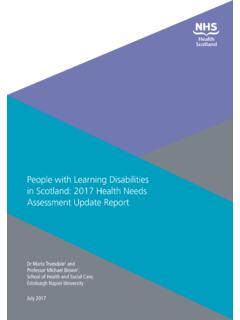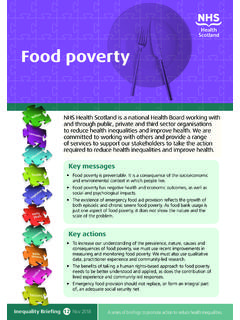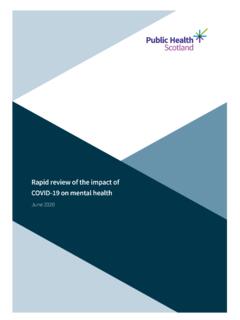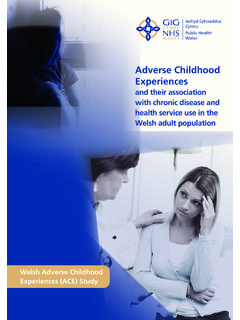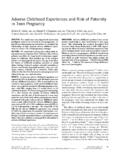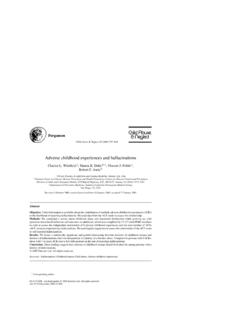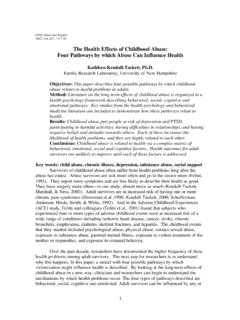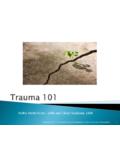Transcription of Tackling the attainment gap bypreventing and …
1 Tackling the attainment gap by preventing and responding to adverse childhood Experiences (ACEs)The Scottish adverse childhood Experiences HubPublished by NHS Health Scotland1 South Gyle CrescentEdinburgh EH12 9EB NHS Health Scotland 2017 All rights reserved. Material contained in this publication may not be reproduced in whole or part without prior permission of NHS Health Scotland (or other copyright owners).While every effort is made to ensure that the information given here is accurate, no legal responsibility is accepted for any errors, omissions or misleading Health Scotland is a WHO Collaborating Centre for Health Promotion and Public Health resource may also be made available on request in the following formats: 0131 314 5300 Introduction Pupil Equity Funding is allocated directly to schools, targeted at those children most affected by the poverty related attainment gap.
2 * This paper builds on existing guidance and local discussions about the use of such funding for sustainable, longer-term work in schools and local authorities by: summarising the links between early adversity, learning and behaviour stating the significance of the relational elements to learning and how schools can create a supportive and inclusive environment for learning suggesting some questions to consider when planning action on the use of additional funding to reduce the attainment gap linking to further resources and forthcoming work which will contribute to informing action on reducing the attainment gap. As with health inequalities, reducing educational inequalities involves understanding the interaction between the social determinants of educational outcomes, including family background, neighbourhood and relationships with peers, as well as what goes on in schools.
3 Indeed, evidence on the most important factors influencing educational attainment suggests that it is families, rather than schools, that have the most influence. Closer links between schools, the family, and the local community are needed. Marmot Review, 2010 This paper has been produced to inform thinking about the impact of adverse childhood experiences and how to use the Pupil Equity Funding to reduce the attainment gap. It highlights key factors that play a role in children achieving their potential. * 2 It has been developed by the multi-disciplinary Scottish adverse childhood Experiences Hub, hosted by NHS Health Scotland. Guidance has already been provided by the Scottish Government, Education Scotland and from local authorities about the use of the Pupil Equity Funding. Universal services, including education and health, give us all the opportunity to realise our full potential.
4 However, depending on life circumstances some people are better able to take up these opportunities than others. There is therefore a risk that services can exacerbate inequalities. The role of universal education in enabling all children to flourish and achieve their full potential can be affected by the extent to which children come to school ready to learn in a classroom. I think it is really important. I would encourage you to see the attainment Challenge and Fund in the broadest sense here it s equipping head teachers with the resources they need, not just to tackle the thing that happens in the classroom but to bring resource to bear to tackle some of the things that happen to children outside the classroom but affect how they do in the classroom. First Minister Nicola Sturgeon MSP, The Gathering, February 2017 3 What are adverse childhood Experiences (ACEs)? adverse childhood Experiences (ACEs) refer to stressful events occurring in childhood (between 0 to 18 years).
5 These impact profoundly on the child s readiness and ability to learn and participate in school life. These experiences include: Figure 1: The truth about ACEs Copyright 2013. Robert Wood Johnson Foundation. Used with permission from the Robert Wood Johnson Foundation. Full infographic is available at: 4 Figure 2: Infographic from an ACE study in Wales1 Trauma in childhood can lead to reduced educational attainment , mental and physical health problems and difficulties in adult relationships, which in turn are highlighted as key factors in producing negative financial outcomes. Children who have experienced abuse and trauma will perform more poorly at school than their peers. A child living with fear and helplessness from experiences outside school cannot focus or learn to the same standard as other children. Issues at home which may affect a child s learning in school include alcohol or substance misuse, poverty, mental or physical ill-health, and children s caring responsibilities.
6 These additional challenges can make arriving at school well-rested, fed, dressed and able to concentrate particularly difficult. Scottish Alliance for Children s Rights, State of Children s Rights in Scotland, November 2016 adverse childhood events can create dangerous levels of stress and derail healthy brain development, which can result in long-term effects on learning, behaviour and health. Neurobiological research indicates that the toxic stress (defined as prolonged activation of stress response systems in the absence of protective relationships) associated with ACEs can lead to physical changes in the way the brain develops and propensity to experience future stress, adopt health-harming behaviours and develop mental and physical ,3 This does not mean that the 5 brain is fixed in this state; there is much that can be done to respond in a psychologically informed way.
7 The role of schools, teachers and the wider support staff is therefore crucial. This clip from the documentary film Resilience ( ) gives a brief overview of the impact of ACEs on neurobiology. Find out more about the film at Children who end up doing well despite adversity have usually had at least one stable committed relationship with a supportive parent, caregiver or other adult. This buffers them from development disruption and builds skills such as the ability to plan, monitor and regulate behaviour and adapt to changing We now know that significant adults in a child s life can provide important attachments for children and this is not confined to parents or Teachers are key figures in a child s life and can provide very important relationships for children and young people. Positive relationships, such as those between teacher pupil, can help repair some of the impaired ways of working (such as the expectations and beliefs that a person develops about themselves, others and the relationships that they have6).
8 Toxic stress from adverse childhood experiences affects our physiology which can undermine the ability to form relationships, regulate emotions, and can also impair cognitive ,8 This potentially has significant implications for a child s ability to engage in school and will most likely result in difficulties with processing information, ability to organise self and work, transitions, and working with others. A national conference on adverse childhood Experiences was held in Edinburgh in November 2016. You can view the presentations at: A short film called The Science of Adversity provides a brief overview of the ACE study, the neurobiology of toxic stress and how to create resilience-building schools. You can watch it here: 6 Pennine Care NHS Trust has provided a short briefing on difficult behaviours in the classroom, why they happen and how to handle them. You can read it at: Addressing adversity within and outwith the school day Thinking about adverse childhood Experiences is especially important for school staff and school communities.
9 Schools are in a fantastic position to help support children and mitigate some of the effects that ACEs may have by recognising the factors which might affect children, building trusting relationships with them in order to support their learning and development and responding in a psychologically informed Building resilience in children aged 6 17 years has been shown to mitigate the negative impact of adverse childhood Nurturing approaches in schools which focus on building strong relationships with children and families has been found to improve social, emotional and educational The importance of taking a holistic approach to children and young people who may have or who are currently experiencing adversity is required if relationships with teaching staff are to support effective learning in school. It requires taking account of all the factors which may be affecting a child or young person and recognising the central importance of relationships.
10 It is proposed that such a child-centred, ACE-informed, rights-based approach, which is founded on an understanding of brain development and attachment theory, will contribute to the achievement of children and young people in schools. 7 Poverty In addition to the ACEs outlined above, there are other types of childhood adversity, including growing up in poverty. Poverty is also a risk factor for experiencing the ACEs outlined above. From surveys conducted in England and Wales and other places we know that ACEs are reported across the whole population. However, having high numbers of ACEs has been found to be related to deprivation, with higher proportions of people in the most deprived areas reporting ACEs. Evidence also shows that poverty impacts on children s health and educational attainment , as well as their future health and life opportunities in adulthood. The focus of this paper is not on direct measures to influence children s material circumstances, rather on responding to the relational and emotional impacts of childhood adversity.
